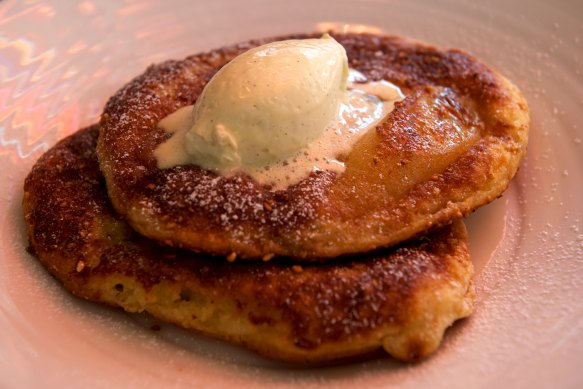Opinion
A second, minute or hour? What counts as a jiffy
David Astle
Crossword compiler and ABC Radio Melbourne presenterGot a second? Maybe two? You won’t need long to read this column. A blink at least, a dozen heartbeats, as today we mark a timely term turning 240 years old, eons compared with a jiffy.
Jiffy, the word, rankles Ellie Leonard and several other emailers. The gripe is imprecision. Put simply, is a jiffy twice a trice or more? On a sliding scale, where does jiffy sit amid a tick, an instant and two shakes of a lamb’s tail? In a flash I dismissed the mystery, but then the question nagged me. For days. Weeks.

Pancakes with a dollop.Credit: Wayne Taylor
Idiom is the enemy of exactitude. Cookbooks teach us that, where sprinkles and smidges of old-time recipes have been usurped by milligrams or quarter-cups. Though dollop, as Dr Jacqui Newling, author of Eat Your History – Stories and Recipes from Australian Kitchens (UNSW Press, 2015), says, has its own mouthfeel. “Say dollop and you feel it fall from your lips in a clump. A dollop of cream is something you lift and drop off the spoon. It has far more emotion than ounce.”
Just as jiffy feels briefer than a second, yet that hunch won’t appease the sticklers. Criminal slang is the likely source, jiffy emerging from the Scottish language, a plausible corruption of gliff – or glance. In 1785 jiffy appeared in Erich Raspe’s satire Baron Munchausen’s Narrative of his Marvellous Travels and Campaigns in Russia.
“Away we went,” the baron writes, “helter-skelter, and in six jiffies I found myself and all my retinue safe and in good spirits at the rock of Gibraltar.” Doing the maths, I can only presume six jiffies equates to four twinklings, maybe three given the historic adjustment.
A century ago, sick of the vagueness, Harvard chemist Gilbert Lewis gave jiffy a calculable length, namely 33.36 picoseconds. To remind you, a picosecond outpaces a nanosecond, being a trillionth of a second compared with a billionth. Fleeting as both seem, the zeptosecond (one sextillionth) and yoctosecond (a septillionth) are downright zippy.
Over time, laser boffins embraced the Lewis jiffy, the nickname handy for calibrating quark emissions and the transitory life of a photon, a term also coined by Lewis. Suddenly jiffy had its long-lost specificity, though most of us missed the memo, still fudging the concept somewhere between split second and New York minute.
Indeed, even scientists began to quibble across disciplines, with London astronomer Edward Harrison adopting jiffy a few years after the Lewis bid, co-opting the term as a figurative ball of string. A maven of quantum physics, Harrison borrowed jiffy to mean the time taken for light to travel a specified distance. Think minuscule. Microscopic. Where the distance may be the width of a nucleon, rather than a cricket pitch.
Coding geeks later joined the party, kneading jiffy into a new duration. Ask a vintage techie and they’ll tell you a jiffy denotes one tick of a computer’s system clock, or roughly one-sixtieth of a second. To muddy the water further, that same fraction has since shrunk to equal one-hundredth of a second, or 10 milliseconds.
Confused yet? That makes two of us. From astral photons to Galaxy phones, the jiffy can mean different things to different experts. For us normal humans, however, let’s keep it sketchy, where a jiffy is quick, and a jiff even quicker. After 240 years of being a blink of an eye, the jiffy is one grey area we need to preserve. Life is exacting enough. I vote we keep the iffiness of jiffiness.
To read more from Spectrum, visit our page here.
The Booklist is a weekly newsletter for book lovers from books editor Jason Steger. Get it delivered every Friday.